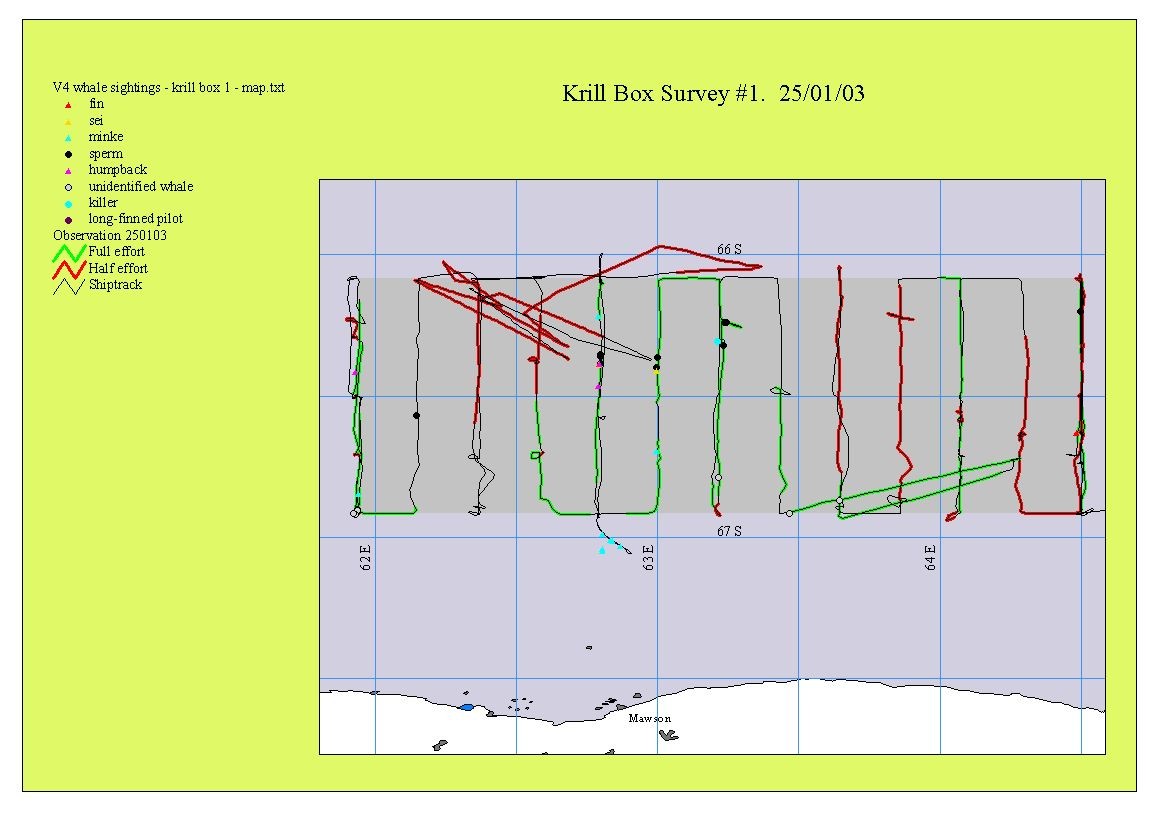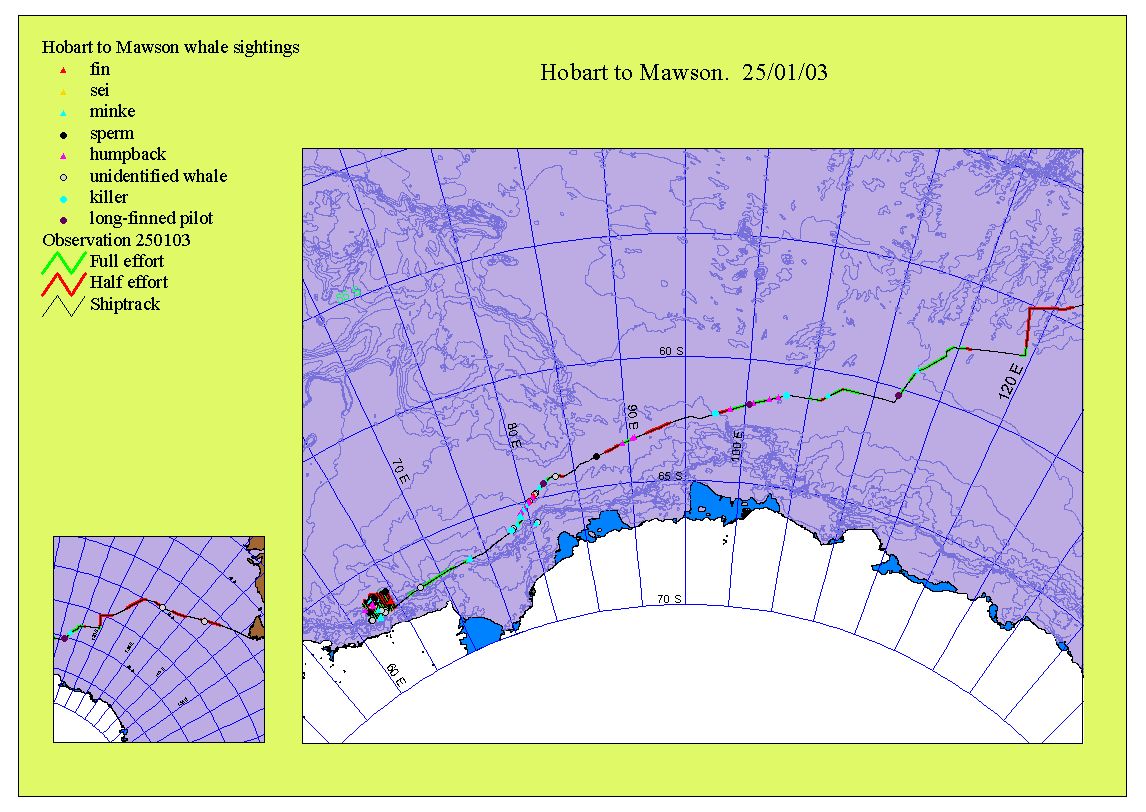Report #2: The Mawson Krill Box – survey 1. (Map 2)
The
research is being conducted in a 60x50 nautical mile 'box' approximately
30 nm
off the coast of

MAP 2.
It
transpires that the satellite-tagged penguins are feeding in about the same
region as in yr 2000/1, so the 'box' has been positioned in the same place
as we did during the KACTAS voyage. The ship steams up & down in a
series of parallel transect lines 5nm apart recording krill abundance below us
using scientific echosounders and sampling where krill
is abundant (or swarm dynamics look 'interesting', i.e. considerable structure
within the swarm) using trawl nets. Additional
programs, like ours, record predator (bird & whale) abundance. Several other projects are investigating plankton
and nutrient ‘turn-over’ in the water, including one which deploys sediment
traps to ‘catch’ sinking plankton and krill faeces.
The oceanographic data will mainly be collected along the outer edges of the
box, but several drogue buoys fitted with
In
a 'nutshell', that's what we'll be doing for the next few weeks.
The first survey of the Krill Box
took 9 days. Each alternate transect
included a ‘night’ repeat of the transect to compare
day & night distribution and abundance patterns of krill (‘night’ is
considered appropriate from 10 AM to 4 PM with midnight
equivalent to about

MAP 1.
A total of 33 sightings of twelve
identification categories were made during this survey (see Table 2). Generally the odontocete
sightings (consisting primarily of sperm whale sightings, with the exception of
one group of killer whales) were made beyond the continental shelf break. It is thought that the sperm whales will
probably all be large males as the females and younger animals do not travel
this far south during the austral summer. The sperm whales ‘log’ on the surface for a
few minutes puffing away as they hyperventilate before their next deep dive
(possibly in excess of 1500m). The
single sighting of killer whales included some interesting behaviour:
Although it was, unfortunately,
approximately 2 nautical miles away, observations through the big-eye
binoculars suggested they may recently have conducted a kill. The group was
first sighted through observing a lot of splashing, followed by one animal
leaping clear of the water in a rapid lunge. The group then spent some time underwater, coming
up in 1s and 2s for a single breath before diving again. There was what looked like an oil-slick on the
water surface and 2 southern giant petrels, a white chin petrel, South Polar skua and several storm petrels flying overhead and
‘dipping’ down to the surface (to pick up pieces of food?).
Mysticete sightings were
spread throughout the ‘box’, although a series of Antarctic minke whale sightings
were made at the ice edge when the ship headed south to allow investigation of
the characteristics of the pack-ice (see the bottom of transect 9, Map 1). The sei whale
sightings included one of 4 animals apparently feeding as they were surfacing
synchronously and facing in the same direction at times (herding?), while at
other times they surfaced in a tight group at different angles to each other
(feeding?).
No obvious feeding behaviour was recorded for humpback and minke whale
sightings.
Penguins foraging trips changed
dramatically during the period that we were conducting the survey:
For the first few days (11-16
January) the penguins were primarily foraging in the continental shelf break
region within the perimeters of the krill box. From the 17th through to approx.
the 25th January they started
spreading through a wider area and many appeared to be spending more time in
deeper waters (approx. 2500m).
Both ‘target’ trawls (aimed at
specific features detected on the acoustics screen) and ‘oblique’ trawls
(conducted at the middle and ends of each alternate transect) yielded few
Antarctic krill. Several trawls
contained fishes, while most comprised a ‘mixed bag’ of invertebrates including
ctenophores and salps, plus Antarctic and crystal krill,
the latter particularly found over the shelf. However, some trawls did yield sufficient live
krill for growth studies conducted on board.
Table 2: Categories of whale sightings during the first
survey of the Mawson Krill Box.
|
Whale species sighted |
Common name |
Total number of sightings: Total
number of animals seen |
|
|
|
|
Balaenoptera physalus
|
Fin whale |
1:1 |
|
Physeter macrocephalus |
Sperm whale |
9:9 |
|
Like sperm whale |
Like sperm whale |
1:1 |
Orcinus orca
|
Killer whale |
1:5 |
|
Balaenoptera borealis |
Sei whale |
2:6 |
|
Undetermined species of minke |
Undetermined species of minke |
1:1 |
|
Like minke whale |
Like minke whale |
3:3 |
Balaenoptera bonaerensis
|
Antarctic minke whale |
5:5 |
|
Megaptera novaeangliae |
Humpback whale |
3:5 |
|
Unidentified whale |
Unidentified whale |
2:2 |
|
Unidentified baleen whale |
Unidentified baleen whale |
4:4 |
|
Unidentified small baleen whale |
Unidentified small baleen whale |
1:1 |